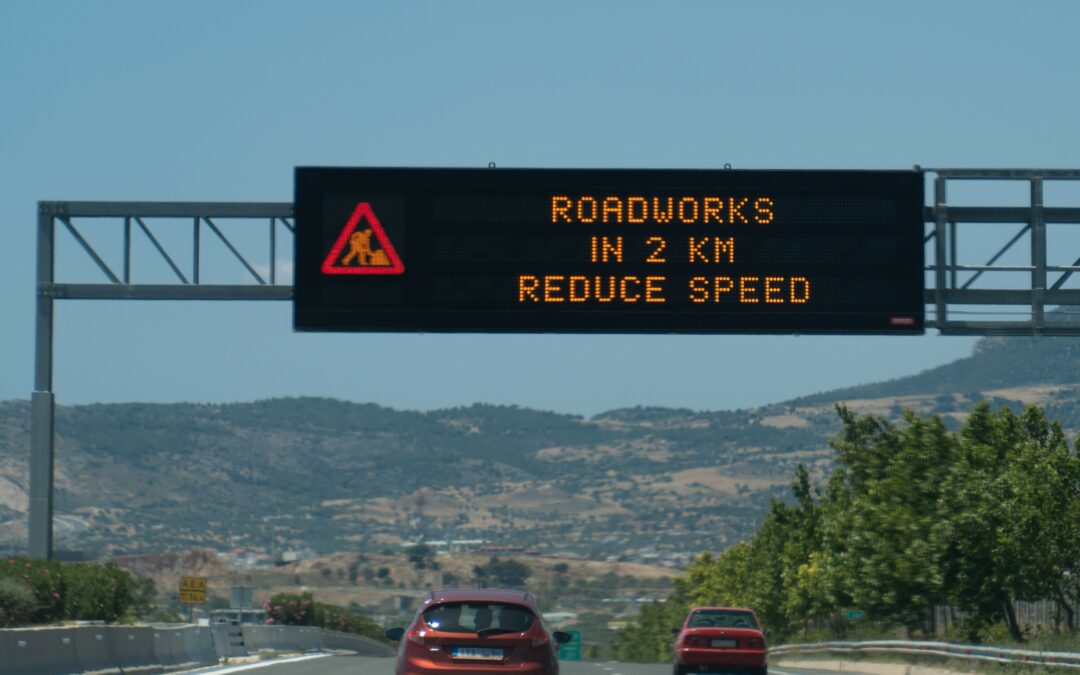Work zones can create unfavorable roadway conditions for motorists and construction workers. As lanes or sections of roadways are closed for construction, bottlenecks and congestion can build, causing decreased capacity and driver uncertainty. Drivers have their route and travel plans disrupted, which can result in frustration and increased aggressive or unsafe driving behaviors. Both construction workers and motorists experience increased safety risk, as high volume and high-speed traffic can result in rear-end collisions and fatal incidents. While static message signs can warn drivers of upcoming construction, the information is not always accurate or reliable, which can increase driver frustration or leave motorists caught by surprise. In response to these issues there are smart work zone systems, which aim to increase safety and decrease driver frustration.
What are Smart Work Zones?
Smart work zones are construction zones that use real-time sensor technology and messaging to inform drivers of work zone conditions. They use portable combinations of equipment that can be utilized in work zones. This equipment includes the application of computers, sensors, and communication technology to provide motorists with real-time information. The goal of smart work zones is to increase safety for drivers and construction workers by preventing collisions and reducing crash damage, and to minimize traffic delays. This increases the productivity of construction workers and decreases the travel time for drivers. Smart work zone systems have the following characteristics:
- Real-time: Traffic data is obtained and analyzed in real-time, allowing information to be continuously updated and transmitted to motorists.
- Portable: Sensors are portable, allowing for flexible and temporary installation.
- Automated: The system is automated and requires little supervision.
- Reliable: Information obtained and transmitted to motorists must be reliable.
5 Useful Smart Work Zone Systems
1. Queue Warning
Queue Warning systems detect congestion near the work zone and warn approaching drivers of upcoming slow or stopped traffic through the use of dynamic message signs. This system gives drivers time to slow or brake, particularly when work zones are in low visibility areas.
Benefits: Fewer rear-end collisions, less severe crashes, and reduced delays.
Use case: IOWADOT used Queue Warning to send alerts to engineers and inspectors via text message when there were slowdowns of over five minutes, allowing them to quickly make adjustments and smooth traffic in the work zone.
2. Travel Time/Delay Monitoring
Travel Time/Delay Monitoring uses real-time information to monitor travel times and inform drivers before they reach the work zone. Through the use of dynamic signs, motorists are told how long the delay is or how much time it will take them to reach a destination, such as the end of the work zone. This reduces motorist frustration from unknown wait times.
Benefits: Reduced driver frustration, reduced delay, reduced congestion, and fewer crashes.
Use cases: MassDOT utilized this system while doing construction on a tunnel within a major commuter corridor, allowing them to inform and reroute drivers effectively. In Texas, U.S.A., based on predetermined speed and occupancy thresholds, dynamic messaging signs were used to display real-time delay information during work on I-35.
TIP: In long work zones where delay messages only apply to a specific section, such as delay time before the work zone, messaging should be as clear as possible. This reduces driver frustration resulting from misconceptions that the delay time shown will be for the entire work zone.
3. Travel Time and Alternate Routes
Similar to Travel Time/Delay Monitoring, this system provides information to motorists such as travel time, queue length, delay, and available reroutes. Information is provided before and within the work zone. This gives motorists real-time information and the option to reroute if desired. The goal of this system is to reroute drivers where possible to avoid congestion.
Benefits: Reduced congestion and delay, improved safety, and increased driver awareness.
Use case: In Minneapolis, SMATS’ WiFi/Bluetooth sensors and data analytics platform calculated live travel times, which were used to update variable message signs. These signs showed comparative alternate route times, which allowed motorists to determine their route.
4. Variable Speed Limits (VSL)
VSL uses dynamic signs in and before the work zone to warn motorists of new speed limits and gradually slow drivers down. This system aims to increase throughput and safety by determining speeds according to current conditions.
Benefits: Fewer collisions, less severe crashes, and reduced delay.
Use case: UDOT used a portable variable speed limit system to reduce speeds near active workplaces without having to reduce the speeds for the entire construction zone, which increased worker safety and minimized driver delay.
5. Dynamic Lane Merge
This system uses dynamic signs to encourage motorists to merge at designated points along the roadway as they approach a work zone. Merge points may vary depending on traffic conditions and volumes. When traffic volumes are high, zipper merging is often encouraged.
Benefits: Reduced driver frustration, fewer crashes, less unsafe merging, and reduced delay.
Use case: MDOT deployed this system on I-94 to reduce aggressive driving and increase driver safety. This system was most effective during the peak traffic hours, and increased travel speeds for drivers.
TIP: When deploying smart work zone systems, it is beneficial to involve the construction contractor throughout planning and deployment. This will allow for optimal placement and usage before and throughout the project.
Smart work zones benefit workers and travelers by providing real-time, reliable information on work zones and roadways. These systems lead to reduced collisions, congestion, and driver frustration, while increasing the safety of workers and motorists. Real-time information allows drivers to slow down, avoid panic maneuvers, and make informed route decisions. By utilizing one or more of these systems, transportation agencies can create safer, smoother work zones!

